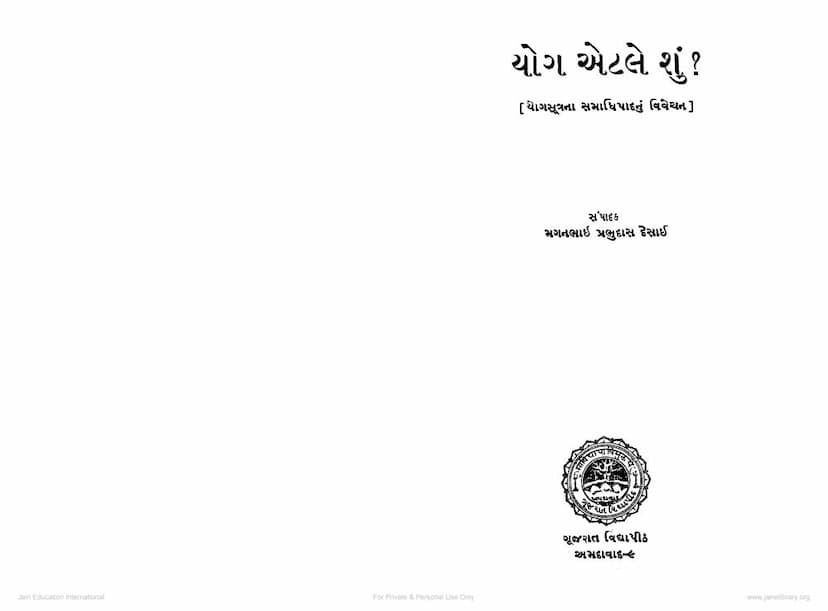Yoga Etle Shu
Added to library: September 2, 2025

Summary
Here's a comprehensive summary of the Jain text "Yoga Etle Shu" (What is Yoga?) by Maganlal Prabhudas Desai, based on the provided pages:
Book Title: Yoga Etle Shu (યોગ એટલે શું?) Author: Maganlal Prabhudas Desai (મગનભાઈ પ્રભુદાસ દેસાઈ) Publisher: Gujarat Vidyapith, Ahmedabad (ગૂજરાત વિદ્યાપીઠ, અમદાવાદ) Content: A commentary on the Samadhi Pada of the Yoga Sutras.
Overall Theme: The book "Yoga Etle Shu" by Maganlal Desai, published by Gujarat Vidyapith, Ahmedabad, is a detailed exposition and commentary on the first chapter (Samadhi Pada) of Patanjali's Yoga Sutras. It aims to demystify yoga, presenting it not as a practice exclusive to ascetics or involving mere physical postures, but as a fundamental principle for life's success and a comprehensive science of consciousness. The author emphasizes yoga's roots in ancient Indian thought and its relevance for modern life.
Key Concepts and Arguments:
-
Yoga as a Science of Life's Success: Desai argues that yoga is the "key" and "mantra" for life's success. It's presented as a profound science that can be applied to any aspect of life, not just spiritual pursuits. The underlying principle of yoga, in any endeavor, is the manifestation of inherent potential.
-
Yoga as a Universal Principle: The author highlights that various traditions (Buddhism, Jainism, Tantra, Shaivism, Shakta) acknowledge and incorporate yoga, though with differing interpretations. The core idea of yoga, as a path to liberation or ultimate well-being, remains consistent.
-
Definition of Yoga: Chittavritti Nirodhah (चित्तवृत्तिनिरोधः): The book centers on Patanjali's definition of yoga as the cessation of the modifications (vrittis) of the mind (chitta). This cessation is not seen as annihilation but as a state where the true nature of the seer (drashta) is realized.
-
The Nature of Chitta (Mind): The text delves into the nature of the mind, describing it as the instrument of consciousness (chetana). It functions through "vrittis" (fluctuations or modifications), analogous to waves on water or frames in a cinema film. The mind's inherent nature is to constantly produce these fluctuations.
-
The Goal of Yoga: Nirodh (निरोध) and its Purpose: The primary purpose of yoga is the nirodh (cessation/control) of these mental fluctuations. This is crucial because when the mind is agitated by vrittis, the Seer (Drashta/Atman) appears to identify with them, leading to suffering and obscuring its true nature. When vrittis cease, the Seer remains in its own pure form.
-
Two Main Paths to Nirodh: Patanjali, as presented in the book, offers two primary paths to achieve this cessation:
- Abhyasa and Vairagya (अभ्यास और वैराग्य): Persistent effort (Abhyasa) and non-attachment/dispassion (Vairagya). Vairagya is understood as detachment from worldly desires, both perceived (drishta) and described in scriptures (anushravika). Abhyasa is the diligent, continuous, and devoted practice towards stabilizing the mind.
- Ishwarapranidhana (ईश्वरप्रणिधान): Surrender to or devotion to Ishvara (a special Purusha, unaffected by afflictions, karma, etc.). This path, also known as Bhakti Yoga or Kriya Yoga, is presented as an alternative or complementary path that naturally leads to the removal of obstacles and the realization of the Self.
-
Historical Context and Interplay of Traditions: The "Prastavik" (Introduction) by Gopaladas Patel traces the evolution of yogic thought from the Vedic period through the Upanishadic, Buddhist, and Jain eras, highlighting the influences and exchanges between these traditions. It also discusses the potential origins of yogic concepts and the contextualization of Yoga Sutras within the intellectual landscape of its time.
-
Yoga Sutras' Approach: Desai emphasizes Patanjali's pragmatic and inclusive approach. Patanjali doesn't get bogged down in sectarian debates about Ishvara but rather presents Ishvara-pranidhana as a practical means. He allows for various supporting practices (like mantra repetition, concentration on chosen deities, or even certain austerities) as long as they contribute to the ultimate goal of mental control.
-
The Nature of Vritti: The book breaks down the "five types of vrittis" as listed in the Yoga Sutras:
- Pramana (प्रमाण): Correct knowledge derived from direct perception, inference, or testimony.
- Viparyaya (विपर्यय): Misconception or false knowledge.
- Vikalpa (विकल्प): Imagination or conceptualization not based on reality (e.g., linguistic constructs).
- Nidra (निद्रा): Deep sleep or the knowledge of absence.
- Smriti (स्मृति): Memory.
-
The Fourfold Classification of Samprjnata Samadhi: The book explains the four states of conscious absorption (Samprjnata Samadhi) described in the Yoga Sutras, which are attained through focused practice:
- Vitarka (वितर्क): Gross object contemplation involving coarse sensory and mental analysis.
- Vichara (विचार): Subtle object contemplation involving finer analysis of impressions.
- Ananda (आनन्द): Contemplation of bliss.
- Asmita (अस्मिता): Contemplation of pure ego or individuality.
-
The Ultimate State: Nirbija Samadhi (निर्बीज समाधि): The ultimate goal is Nirbija Samadhi, or causeless concentration, where even the subtle impressions (samskaras) are overcome, leading to the cessation of all mental activity and the realization of the Seer's true nature. This is the state of liberation or Kaivalya.
-
Importance of Svadhyaya and Ishvarapranidhana: The text reiterates the importance of self-study (Svadhyaya) and devotion to Ishvara (Ishvarapranidhana) as pathways to spiritual insight and progress.
-
Yoga as Education: The book frames yoga as the ultimate "life education" or "pedagogy," which encompasses physical health (asanas, pranayama), mental discipline (pratyahara, dharana, dhyana), and moral conduct (yama, niyama). It stresses that physical health is a means, not the end, of yoga.
-
Practical Application: Desai advocates for a practical and accessible understanding of yoga, applicable to householders and not just renunciates. The emphasis is on integrating yogic principles into daily life through conscious effort and dispassion.
Key Takeaway: "Yoga Etle Shu" presents yoga as a profound, scientific, and holistic system for self-transformation and life fulfillment, deeply rooted in Indian philosophical traditions but made accessible for modern understanding and practice. It meticulously breaks down Patanjali's Yoga Sutras, offering a clear path toward mental control, inner peace, and ultimately, self-realization.